Chi Cygni bright. Chi (χ) Cygni, one of the brightest red long-period variable stars, is having an unusually bright maximum. For the last two weeks it's been about magnitude 3.8, very plain to the naked eye. Look for it adding to the bottom part of the shaft of the Northern Cross, between Eta (η) and Beta (β) Cygni. Cygnus is reasonably well up in the east by about 11 p.m., with the Northern Cross lying on its side. Comparison-star chart and two-year light curve up to the present courtesy AAVSO.
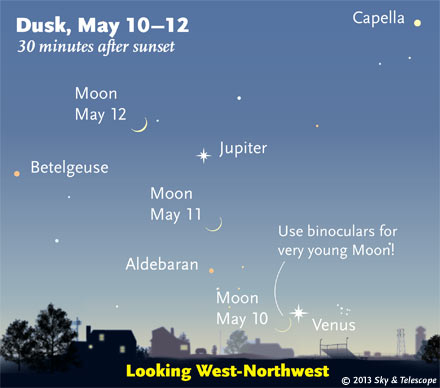
Starting soon after sunset on Friday the 10th, use binoculars to look for the hairline Moon low near Venus. The Moon is much easier by Saturday the 11th.
The visibility of the fainter objects in bright twilight is exaggerated here. These scenes are drawn for the middle of North America. European observers: move each Moon symbol a quarter of the way toward the one for the previous date. For clarity, the Moon is shown three times actual size.
Friday, May 10
Note the time, then determine how long this is since new Moon occurred yesterday at 8:28 p.m. Eastern Daylight Time. The difference tells the Moon's current age. Does it break your personal record?
Saturday, May 11
Sunday, May 12
Monday, May 13
Tuesday, May 14
Wednesday, May 15
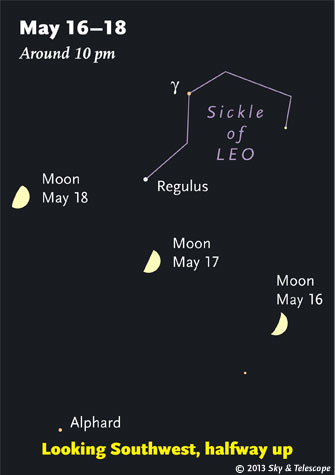
The Moon, currently south of the ecliptic, passes well below Regulus as it waxes across the evening sky. (The ecliptic practically hits Regulus.)
Thursday, May 16
Friday, May 17
Scale model: If the Moon were a BB at reading distance 15 inches from your face, Regulus would be a house-size, blue-white-hot fireball at the Moon's actual distance.
Saturday, May 18
Find Antares about three fists at arm's length to the lower left of Saturn. Along the way you'll pass fainter Alpha Librae (not far from Saturn), and not-so-faint Delta Scorpii (relatively close to Antares).
Want to become a better amateur astronomer? Learn your way around the constellations. They're the key to locating everything fainter and deeper to hunt with binoculars or a telescope.
For an easy-to-use constellation guide covering the whole evening sky, use the big monthly map in the center of each issue of Sky & Telescope, the essential guide to astronomy. Or download our free Getting Started in Astronomy booklet (which only has bimonthly maps).

The Pocket Sky Atlas plots 30,796 stars to magnitude 7.6 — which may sound like a lot, but that's less than one star in an entire telescopic field of view, on average. By comparison, Sky Atlas 2000.0 plots 81,312 stars to magnitude 8.5, typically one or two stars per telescopic field. Both atlases include many hundreds of deep-sky targets — galaxies, star clusters, and nebulae — to hunt among the stars.
Sky & Telescope
Once you get a telescope, to put it to good use you'll need a detailed, large-scale sky atlas (set of charts). The standards are the little Pocket Sky Atlas, which shows stars to magnitude 7.6; the larger and deeper Sky Atlas 2000.0 (stars to magnitude 8.5); and the even larger Uranometria 2000.0 (stars to magnitude 9.75). And read how to use sky charts with a telescope.
You'll also want a good deep-sky guidebook, such as Sue French's Deep-Sky Wonders collection (which includes its own charts), Sky Atlas 2000.0 Companion by Strong and Sinnott, the bigger Night Sky Observer's Guide by Kepple and Sanner, or the beloved if dated Burnham's Celestial Handbook.
Can a computerized telescope replace charts? Not for beginners, I don't think, and not on mounts and tripods that are less than top-quality mechanically (able to point with better than 0.2° repeatability). As Terence Dickinson and Alan Dyer say in their invaluable Backyard Astronomer's Guide, "A full appreciation of the universe cannot come without developing the skills to find things in the sky and understanding how the sky works. This knowledge comes only by spending time under the stars with star maps in hand."
This Week's Planet Roundup
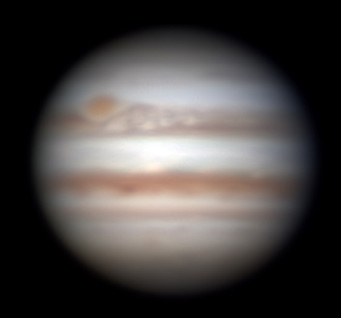
Jupiter on May 6th. Detail on Jupiter is becoming hard to observe now that the planet is sinking low into thick air after sunset. Jupiter is also on the far side of the Sun, appearing only 70% as large as it did at opposition last December.
Still, Christopher Go in the Philippines was able to image the Great Red Spot and the white turbulence following behind it, the color difference between the South Equatorial Belt (in which they're embedded; south is up) and the North Equatorial Belt, and the presence of the thinner North Temperate Belt and the absence of its southern counterpart. That's about the level of detail that typical amateur telescopes usually show visually when Jupiter is better presented.
Mercury is hidden in the glare of the Sun. But it's getting ready down there to come up for a very interesting evening-twilight apparition in the next few weeks.
Venus (magnitude –3.9) is beginning an evening apparition that will continue the rest of this year. Can you pick it up yet? Look about 20 minutes after sunset just above the west-northwest horizon (well to the lower right of Jupiter as seen from mid-northern latitudes).
And watch as Venus and Jupiter draw together this month, by 1° per day. They're 18° apart on May 10th and 11° on the 17th. Their conjunction comes on the 28th, when they'll be a close, 1° couple — with Mercury right alongside.
Mars remains hidden in the glare of the Sun.
Jupiter (magnitude –2.0, in Taurus) is the first "star" to come out in the west after sunset, a little lower every day. It sets around the end of twilight. Near it are the horn-tip stars of Taurus, Beta and Zeta Tauri. Much farther to Jupiter's upper right is bright Capella.
In a telescope, Jupiter is not only blurred by the poor low-altitude seeing but has shrunk to a disappointing 33 arcseconds wide, about as small as it ever gets.
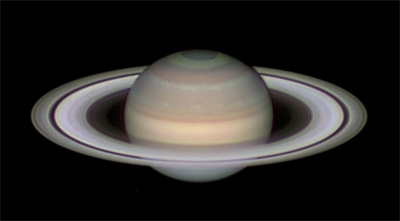
"Here is an image of Saturn taken on April 20th from Mt. Olympus, Cyprus (1950m altitude) under excellent observing conditions," writes Damian Peach. "Probably the best view I've had of the planet in the last few years. Periods of extremely steady seeing prevailed and allowed a very clear view of the planet and rings. A really memorable and enjoyable night on Cyprus's highest peak."
North is up. Note the north polar hexagon. The thin whitish zone at mid-northern latitudes is the remains of the great storm of 2010–11. Several brightness minima can be seen across the ring system. Peach used a 14-inch Celestron Schmidt-Cassegrain telescope.
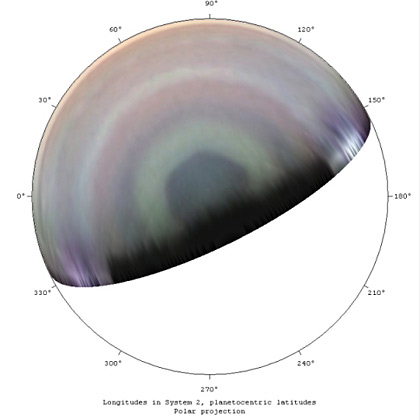
Yes, it is a polar hexagon! The Voyager 2 spacecraft first revealed its shape, but now that Saturn's north polar region has come into Saturnian summer sunlight, amateur Damian Peach recorded the shape of the Hexagon as clear as day from Earth in this image taken on April 21, 2013, and re-projected as this pole-on view.
Damian Peach
Saturn (magnitude +0.2, in Libra) is two weeks past opposition and climbing higher in the evening sky. It glows low in the southeast after nightfall (lower left of Spica and farther lower right of Arcturus), and is highest in the south around midnight. Stay up late with your scope.
Saturn's rings are nicely tilted 18° from our line of sight. See our guide "Scrutinizing Saturn" in the May Sky & Telescope, page 50, or the shorter version online. And identify Saturn's many moons at any time and date with our SaturnMoons utility or handier app.
Uranus (magnitude 5.9, in Pisces) is low in the dawn.
Neptune (magnitude 7.9, in Aquarius) is low in the east-southeast just before dawn.
All descriptions that relate to your horizon — including the words up, down, right, and left — are written for the world's mid-northern latitudes. Descriptions that also depend on longitude (mainly Moon positions) are for North America. Eastern Daylight Time (EDT) equals Universal Time (also known as UT, UTC, or GMT) minus 4 hours.
Like This Week's Sky at a Glance? Watch our SkyWeek TV short, also playing on PBS.
To be sure to get the current Sky at a Glance, bookmark this URL:
http://SkyandTelescope.com/observing/ataglance?1=1
If pictures fail to load, refresh the page. If they still fail to load, change the 1 at the end of the URL to any other character and try again.
 0
0
Comments
You must be logged in to post a comment.